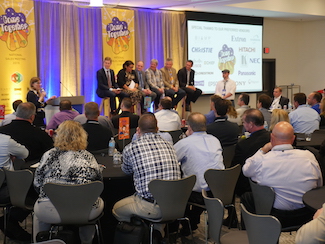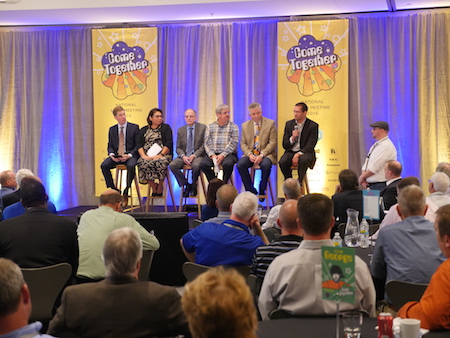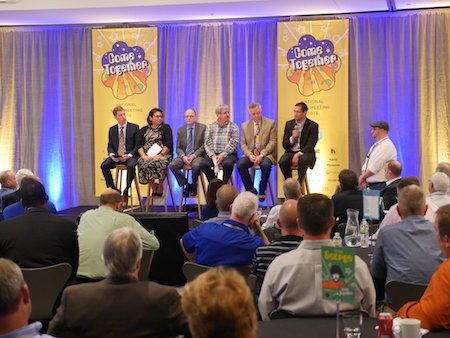“Challenge is where competitive advantage is built.”
David Labuskes dropped the mic.
Well not really, but the InfoComm CEO is always saying things that are worthy of a little startled attention. Which worked out well on this occasion, because he was firing the audience up for AVI Systems’ first-ever company-wide National Sales Meeting in Minneapolis, MN last fall. He was standing in front of a room populated with arguably one of the industry’s best-trained sales forces, responsible for driving some pretty stunning growth across the integration firm’s 17 offices.

Kirsten Nelson (standing left), AVI National Sales Meeting
Which leads us to the reason why a company that recently celebrated its 40thAnniversary was hosting its first official national sales meeting. Founded in 1974 by industry booster, and all-around good guy Joe Stoebner, AVI Systems began as a regionally run family operation and tipped the scales into mid-sized status last year with more than 500 employees. Joe is now Chairman at the company, and his equally engaged and engaging industry leader and association board member son, Jeff Stoebner, holds the position of President and CEO. (For more about all the wire Jeff had to pull to climb his way up to the top, read his
2015 SCN Hall of Fame profile.
So, AVI Systems always knew it was going to be big, but it’s new to being big. But it better get used to it, because with 17 offices across the country, it’s just getting bigger. Fortunately, its team members are enjoying every step of that growth, because the operation is an employee-owned ESOP enterprise. That’s a fact that will remain true regardless of whether the Stoebners are at the helm or not. “The ESOP will naturally evolve our next group of leaders,” Joe Stoebner said in his opening remarks, and as such, “The opportunity for advancement is great within the company.”
Sounds pretty ideal, right? But that picture didn’t just create itself. AVI Systems leadership is keenly aware, as Jeff Stoebner put it, “That few AV companies have been able to grow in scale at the rate necessary to keep up with business. There simply aren’t schools that turn out AV pros. So we have to create them or become them ourselves.”
Which leads to AVI’s vision statements, which are worth paying attention to if you feel like Jeff Stoebner, who said: “Relevancy is actually what keeps me up at night.”
The future, for AVI Systems, is measured in three-year increments. It used to be set in five-year increments, and the team revisited that prognostication every year, but the quickly evolving nature of the AV business has made it necessary to work in the shorter-term.
So, what will AVI Systems look like in 2019? “We will have the best trained workforce in our industry,” Jeff Stoebner began, and “we will make buying an exceptional experience—it also has to be exceptional, not just the user experience, but the buying experience.”
The process toward actualizing those goals has already been in the works for a year, and with the dawn of 2016, AVI Systems is rolling out several major internal and external initiatives to guarantee satisfaction on all fronts. The company is building a new education facility in a separate building, where it will continue its in-house CTS education. Meanwhile, in its headquarters, a new leadership and employee development center will be built. “Education,” Jeff Stoebner said, “will be the biggest investment AVI Systems makes, bar none, in the next five years.”
That said, the emphasis isn’t just on technical education. “We don’t need to be an engineering-driven company, a sales driven company, or an accounting driven company, we need to be a customer-driven company,” he asserted. That means the firm has been going through the grueling task of changing all of its internal workflows. The revamp has entailed documentation of all processes and procedures, retirement of certain software systems, implementation of better tools for internal document management and sharing, and a new fleet management system handling over 100 vans on the street.
As ever, the changes will benefit AVI Systems employees as much as customers, as the new systems are meant to empower all team members to become knowledge workers. The entire system of AVI Systems has been streamlined to create less waste in every sense, which will present results that hopefully are as seamless and enjoyable for customers as well.
So how does this correlate with the “Challenge is where competitive advantage is built” assertion that InfoComm’s Labuskes declared at the start of the AVI Systems National Sales Meeting? Well, it looks like AVI Systems’ emphasis on customer experience is right on the money.

AV Nation PanelAccording to InfoComm, AV firms’ future depends largely on the customer experience. Right now, we’re still trying to simplify extraordinarily complex AV systems to imitate the experience offered by mobile devices and the personal devices that customers use in the workplace. But we should be aiming higher, because, in fact, our customer is now higher up in the food chain.
“Some of you were selling integration services to the CIO 10 years ago, but all of you are today—the CIO is controlling the entire budget,” Labuskes said. Meanwhile the CIO’s world is changing: As everything they used to manage moves to the cloud, now they’re looking for other ways to look like the hero in their enterprise. “That leaves us with 500 CIOs looking to bring more to discussions about strategy and competitiveness within the organization,” Labuskes said. “You need to be talking to CIOs about how the outcomes that your connectivity provides will shift the competitiveness of their organization, that’s what you’re selling. That’s very much your value.”
So instead of talking about the experience in the room, he proposed “Talk about how if you invest in this system, you’re going to make better decisions that will help you compete. Address the competitive advantage to your customer.”
Then, remember that you’re talking to the customer about what they need, not about why they need your company in particular. Talk less about how your company is different than the three other AV companies being considered on a project, and focus on what makes the customer different from their competitors, and how you can help improve their internal operations to help assert that difference for competitive advantage.
Now that you’re dealing with the C-suite, it’s even more important to forget about trying to provide something “good enough” to match the experience of using a mobile device. InfoComm’s recent research into “exceptional experience” has shown that the way to get past “good enough” is simply to provide an example of better. “Once you’ve had better, you want better,” Labuskes said. “The first time you drive a fast, luxurious, experientially superior car, you want that again.” Stop selling something that will replicate good enough. Go for better, or as Labuskes said, “This isn’t fast-food-level quality, where we take it down to a level that we can produce anywhere in the world and it will taste the same.” This is luxury.
